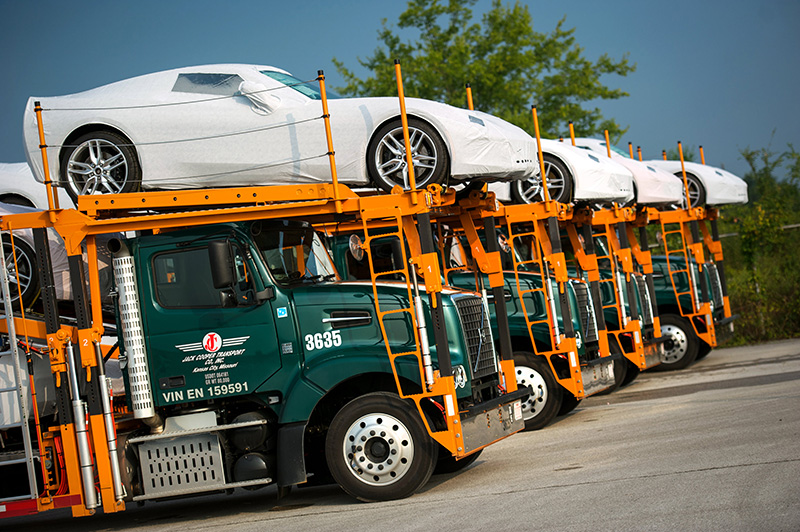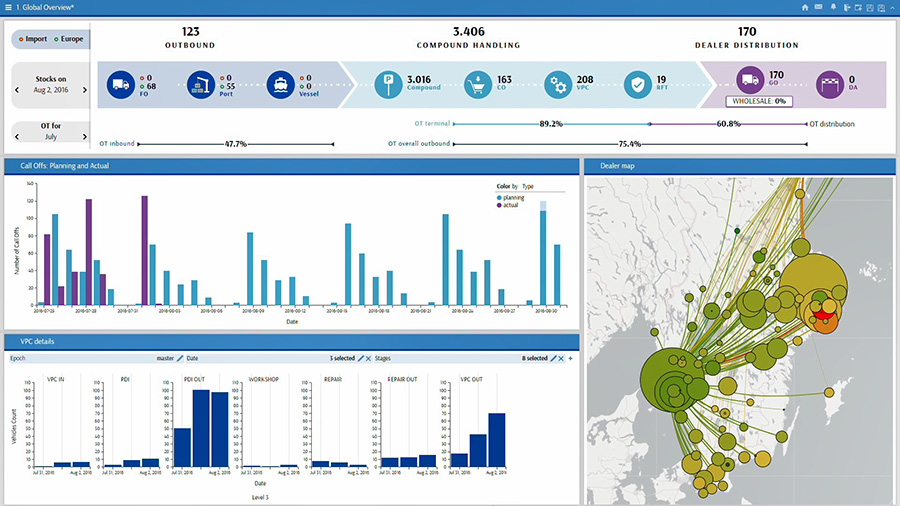 In recent years, growing computer power, advanced software and algorithms for logistics planning have led to a rise in the use of the transport management system (TMS), which enables companies, among other things, to receive, plan, monitor and report on collections and deliveries. Some manufacturers and logistics providers have implemented systems to help plan entire segments of their supply chains, from supplier through to factories and across distribution operations.
In recent years, growing computer power, advanced software and algorithms for logistics planning have led to a rise in the use of the transport management system (TMS), which enables companies, among other things, to receive, plan, monitor and report on collections and deliveries. Some manufacturers and logistics providers have implemented systems to help plan entire segments of their supply chains, from supplier through to factories and across distribution operations.
Such software and planning systems are also highly relevant for a wide range of purposes in outbound automotive logistics systems, including for the execution of transport activities and the creation of transparency in relation to distribution flows, increasing transport load rates and auditing freight invoice and payments. The use of such systems is governed by differences in strategies and legacy IT systems at manufacturers, some of which may drive whether companies turn to external providers’ systems or oversee a system internally.
Georges Bory, managing director and founder at operational analytics solutions outfit ActiveViam, believes that an outbound TMS is now a “must-have” tool for third party logistics providers overseeing outbound supply chains, largely because of their role in managing key administrative and work processes.
However, when it comes to carmakers, Bory stresses that the key measure of usefulness is the ability to combine TMS data with other sources, some of which may include information gathered from inbound networks, as well as systems that oversee all aspects of outbound distribution, including yard and inventory, damage claims and insurance. Such complete gathering of data is especially important if the goal is to provide full visibility about final vehicle delivery – an objective that could become more important as more elements of car purchasing migrate online.
“The current goal carmakers are looking to achieve is to give visibility on delivery of the car to the final customer, as people have become accustomed to being able to track the delivery of their purchases online, and that means aggregating data from the TMS, but also from other systems such as the yard management system, the light manufacturing system and the damage reporting system,” Bory says.

In-house versus externalAccording to Buelent Ileri, director of transportation and logistics at agricultural manufacturer Agco, only a few automotive manufacturers currently operate an in-house TMS for outbound logistics, with the majority opting for systems supplied by external providers. Although he admits some companies may be afraid that an external approach would lead to a loss of control, he believes the opposite is nearer the truth.
“In today’s environment it is highly recommended to use the experience and knowledge of an external provider – industry expertise, global deployments and flexibility are most important. The best case is when the external provider uses the TMS by itself to have first-hand experience when continuing to develop the system,” he says.
Agco has worked with German-based software provider 4Flow to implement a TMS that runs the company’s transport network as a neutral, non-asset provider.
However, even if manufacturers usually turn to specialist software providers for systems, some will choose to operate and run the system in-house. Madeleine Halldén, business IT director at Volvo Cars, explains that the OEM’s TMS for outbound, which is supplied by an external provider, is mainly used for operational transport management, which the carmaker’s in-house logistics team uses to manage its own network.
Halldén believes that the relative merits of in-house systems, as opposed to a bought-in TMS, depend very much on the existing amount of process complexity when compared to the availability of in-house knowledge. At Volvo, although some systems were ‘off the shelf’, implementing them has required many modifications.
ActiveViam’s Georges Bory points out that a range of both in-house and external systems tends to be used by companies, and argues it is difficult to assess which approach is the most common – with some car manufacturers ‘insourcing’ the running of their TMS while others rely on logistic providers. For him, the main advantage for insourcing is the ability to have an end-to-end control tower that allows carmakers to then have 3PLs compete for each segment of their business and lower costs.
“Meanwhile, the main benefit of relying on a single 3PL or 4PL contractor, for a carmaker, is that you don’t need to invest in your own sophisticated and complex information systems – not only TMS, but also yard management systems and light manufacturing systems – with their accompanying team of IT and business managers,” he says.
 "In today’s environment it is highly recommended to use the experience and knowledge of an external provider... The best case is when the external provider uses the TMS by itself to have first-hand experience when continuing to develop the system." - Buelent Ileri, Agco
"In today’s environment it is highly recommended to use the experience and knowledge of an external provider... The best case is when the external provider uses the TMS by itself to have first-hand experience when continuing to develop the system." - Buelent Ileri, Agco
Dominic Regan, European senior director for value chain execution portfolio at enterprise software provider Oracle, agrees that there is still a mix of options – with some automotive companies seeing the advantage of deploying their own TMS and bringing control of transport in-house, while others still prefer to rely on specialist logistics providers to deliver this service for them.
“When insourcing, many carmakers feel they have greater visibility and control of the transportation process, have an enhanced financial transparency that can be applied across the business, are able to react faster to changes in operational demands and are less subject to the constraints of being reliant on a limited set of service providers,” he says.
“Those who outsource, however, typically do so in the belief that the physical operation of outbound logistics is not their core competence, and that leaving it in the hands of reliable, specialist service providers delivers a hassle-free service at an acceptable cost,” he adds.
Setting the right priorities for integrationWhen it comes to outbound logistics, Regan suggests that some manufacturers are also seeking value in both finished vehicle and inbound logistics. In both cases, he says that the return on investment will come from the capacity of a TMS to provide the visibility necessary to meet customer promises, whether in terms of finding and expediting a specific vehicle or specification to meet a confirmed delivery date, or ensuring parts are delivered to minimise time off the road.
[mpu_ad]According to Regan, major carmakers, such as FCA, are already seeing the benefits of controlling their processes, not just in terms of the physical movement of vehicles but also by having more granular visibility of the financial aspects of the outbound supply chain. He also points to a multi-year business and IT transformation project at General Motors called Global Logistics Integrated Design and Execution (GLIDE), which includes implementing software and transport management systems across the supply chain.
“General Motors, with its GLIDE initiative, is one of the pioneering companies in the automotive sector who are looking to have a single means of controlling transportation across both inbound and outbound logistics,” he adds.
Julian Schulcz, executive vice-president at 4flow, believes it is of high value to manage the inbound, intercompany and outbound network in the same TMS. “The bigger the network and possibilities of getting something from A to B, the higher the potential transportation cost savings,” he says. “Besides, running and maintaining one system is more efficient than having different systems in place for the same purpose of managing transportation.”
However, although he admits there is evidence of some collaboration with inbound networks, Regan argues this is “mostly opportunistic”, with less analysis taking place in the automotive industry than might be seen in other sectors such as retail, high-tech or consumer goods.
As well as managing delivery and transport flows, 4flow’s Julian Schulcz points out that other potential uses for transport management systems in outbound include integrating planning phases with execution, including inventory and production data, transport visibility and forecasts.
“Preventive exception management can increase network performance and avoid disruptions beforehand and decrease premium freight, for example. Moreover, connecting demand planning to transportation management improves inventories and availability. Visibility in regards of tracking and tracing is another potential use in outbound,” he says.
One interesting example of how such systems work in practice is the Traffic Pad TMS developed by software company Mandata, which displays outstanding jobs, a live pool of available resources – including vehicles, drivers, sub-contractors and trailers – and planned work, which updates in real time as work is progressed. Tracy Welford, head of marketing at Mandata, explains that the TMS has already been used successfully by BCA Logistics, a UK-based provider of vehicle remarketing logistics services for the automotive sector, and part of auction firm BCA.
“Where you would once see the locations of your vehicles in one system, driver or vehicle performance in another, driver availability on a spreadsheet and workshop maintenance details on another system, all of this information can now be held or imported and displayed in the TMS for everyone to see,” she says.
Another interesting example is the mobile vehicle inspection and tracking app developed by VINspector, which can act as an enterprise-level system for large volume movers of OEM and privately owned vehicles. In recognition of the fact that logistics providers have existing systems, Antony Tyshuk, chief executive at VINspector, reveals that the product was developed to be integrated not only via API (application program interface) but also with direct database connectivity.
“We identified our niche – vehicle inspection via iOS/Android mobile app – as something purveyors of logistics systems would have to invest a considerable amount of resources to develop, implement and support. The goal is to have our solution as a seamless part of our customer’s overall existing system,” he says.
According to Halldén, Volvo Cars also has plans to combine all activities associated with yard management systems, payments, ePod and damage reporting systems into a single package – chiefly as a means of achieving what she describes as “full process support”.
For Regan, the key is to first look at the overall end-to-end outbound process from a business and operational perspective and, from this, to identify the necessary integration touchpoints together with their required format, content and frequency of operation, as well as detemining which points have the greatest priority.
“This is important because not every integration can, or indeed should, be treated the same. Because of the legacy nature of much of the IT infrastructure utilised in the automotive sector, it is important to determine this integration approach as part of the overall IT strategy, since both the development and complexity of these integrations may be influenced by availability of suitably experienced IT personnel, ability of legacy systems to handle real-time integration, ongoing system replacement strategy and so on,” he says.
In Regan’s view, the nature of any workflow then used to drive subsequent system activities is almost as important as the integrations, particularly since this workflow is often the glue that links disparate applications and processes together.
“The workflow can be used to determine, shape and optimise the system interdependency, for example between the TMS and compound management. Since not every integration can be developed simultaneously, it can often be important that any TMS control tower, which sits at the hub of the other applications, can be scaled up flexibly,” he says.
“This is somewhere that a cloud approach can help, since it lets the user start small, to prove the value to the business, then scale rapidly as volumes grow, while avoiding a lot of the large upfront investment costs that have led to questions over the business case in the past,” he adds.
 Volvo’s Madeleine Halldén thinks a TMS has just as many benefits for both outbound and inbound operations
Volvo’s Madeleine Halldén thinks a TMS has just as many benefits for both outbound and inbound operationsMeanwhile, Schulcz notes that a TMS does not necessarily have to cover all functionalities, but should instead be able to connect to other complementary solutions. That said, he stresses that core functionalities such as planning, execution and freight cost management should always be covered.
“The best case is when the external provider has partners in place that deliver the complementary solutions,” he adds.
Outbound’s different dynamicsAt Volvo, Halldén’s view is that the dynamic for the distribution process is more varied and less predictable – largely because it also “consumes” the variation from production processes at the manufacturing plant.
“That said, it does not affect the systems as such – it is more as a result of a business rule definitions setting,” she adds.
Georges Bory agrees that, compared to an inbound TMS organised around manufacturing schedules, an outbound TMS is less predictable because of the dynamic nature of sales forecasts. Moreover, he points out that the distances between plants and dealers are often very long, and often cross seas or borders, which leads to much more frequent disruptions that have to be resolved, and more chance to waste time and money or even to lose cars entirely.
“In terms of systems, not just the TMS, it means that you can’t afford to be looking just at the present and the past; you need to be able to look forward and anticipate the future accurately,” he says.
 "In terms of systems, not just the TMS, it means that you can’t afford to be looking just at the present and the past; you need to be able to look forward and anticipate the future accurately." - Georges Bory, ActiveViam
"In terms of systems, not just the TMS, it means that you can’t afford to be looking just at the present and the past; you need to be able to look forward and anticipate the future accurately." - Georges Bory, ActiveViam
Even so, Regan stresses that the predictability profile can change dynamically in both the manufacturing and outbound logistics environment.
[related_topics align="right" border="yes"]“In manufacturing, the nature of production forecasting often means that demand can be predicted, albeit over a relatively short, 24-hour, timescale. Changes in real-time production sequencing can then require rapid re-optimisation of the necessary logistics,” he says.
When it comes to outbound logistics, he observes that the variability can depend on a number of factors, such as whether it occurs within a build-to-stock or build-to-order supply chain. In the build-to-order environment, Regan argues that the TMS is effectively responsible for meeting the demands of the end customer, meaning that logistics may have to be optimised on almost a VIN-by-VIN basis, with the need to expedite or delay accordingly.
“Within a build-to-stock environment it is more about volume optimisation, though the identification and expedition of a suitably specified vehicle can suddenly shift from ‘non-critical’ to ‘critical’ on the basis of the next customer walking into the dealer, which is clearly something that is in itself very difficult to predict,” concludes Regan.


































